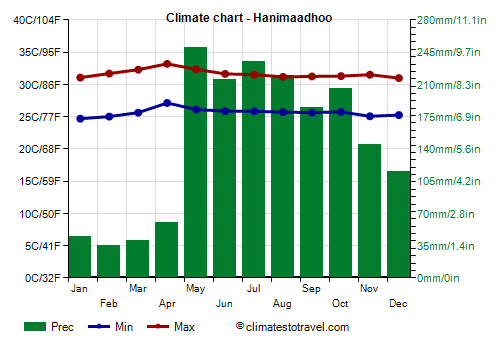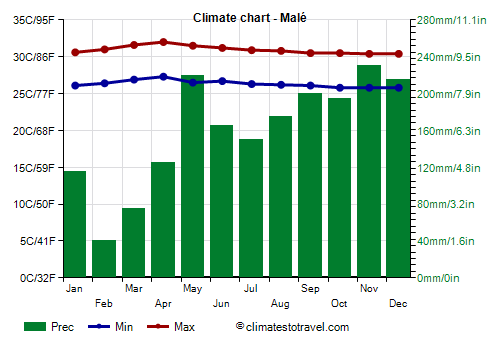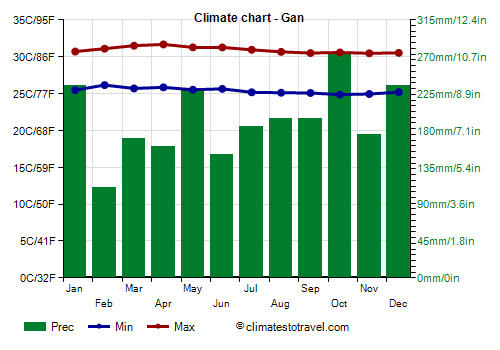Select units of measurement for the temperature and rainfall tables (metric or imperial).
Average weather, temperature, rainfall, sunshine
The Maldives, islands of the Indian Ocean located to the southwest of India, have a
tropical climate, hot all year round and influenced by the
monsoons. The
south-west monsoon, from late April to September, it's stronger on the northern islands, and it's accompanied by the wind, which can make the sea rough and therefore may discourage activities such as diving, and it's also accompanied by higher humidity and more frequent cloudiness. The
northeast monsoon, from October to December, it's quieter and simply brings showers and thunderstorms in the afternoon or evening, especially in the southern atolls.
The
driest period, outside the monsoons, runs from January to April and is felt more on the northern atolls.
The
temperatures are stable. Relative humidity is high and stable throughout the year as well, around 80%. However, between March and May, there is a slight increase in temperature and in the feeling of sultriness as well, especially in the northern atolls; in fact, in this period, the maximum temperature rises to 32/33 °C (90/91 °F) and the minimum temperature to 26/27 °C (79/81 °F).
As is common in tropical areas, the
rains mostly occur in the form of short and intense downpour or thunderstorm. Total annual rainfall is a bit more abundant in the southern atolls, where it hovers around 2,200/2,300 millimeters (87/91 inches) per year, and less abundant in the north, where it hovers around 1,700/1,800 mm (67/71 in) per year. The difference is mainly due to the fact that in the central and northern atolls there is a relatively dry season from January to mid-April, which is more pronounced in the northernmost atolls.
The
sun in the Maldives shines for more than 2,700 hours a year. There is no season when the sun disappears, although there may be days, or periods of a few days, in which the sky is often cloudy, especially in the season of the southwest monsoon (late April-September).
The climate in detail
North
Hanimaadhoo

In the
northern atolls, the warming between March and May is more evident. In
Hanimaadhoo, one of the northernmost islands, located at almost 7 degrees north latitude, in April 2016 the temperature reached 35 °C (95 °F), which represents the heat record of all the Maldives.
In the northern atolls, there is a fairly defined
dry season between January and April, while the wettest period is from May to October.
The sun in the northern atolls shines more often in the dry period, from January to April.
Center
Malé

In the
central atolls, which also include the capital,
Malé, situated at 4 degrees north latitude, temperatures are more stable, however, here too there is some warming from March to May, when the temperature can reach 34 °C (93 °F) on the hottest days.
In Malé, rainfall amounts to about 1,900 mm (75 in) per year. Here, there is a rainy period which runs from May to December, while the least rainy months are February and March, when precipitation drops below 100 mm (4 in) per month.
In Malé and the central atolls too, the amount of
sunshine is good from January to April, and the sunniest months are February and March. In the rest of the year, and even in the least sunny months, the sun shines for a good number of hours, on average about 6 and a half per day.
South
Gan

In Gan, on Addu Atoll (or Seenu), the
southernmost island of the Maldives, temperatures are even more stable.
In Gan, there is no dry season, so the climate can be defined as
equatorial (in fact, the atoll is located just south of the Equator). We are in the wettest area of the Maldives.
In Gan and the southern atolls, the sunniest period is from February to April, as January is still a rainy month, while the sun shines a little less often from July to September.

Sea temperature
The
sea in the Maldives is warm all year round. For example, in Malé the water temperature ranges from 28 °C in January to 30 °C in April and May (82 to 86 °F).
Tropical cyclones
The Maldives can be occasionally reached by tropical cyclones, which usually affect these islands in the
early stages of their formation (as happened with a tropical depression in May 2016, which then became Cyclone Roanu and moved northwards), or they
brush them as they pass further north over the Indian Ocean, as happened with Cyclone Ockhi, which struck more directly Sri Lanka and Southern India in early December 2017.
However, being that they are flat islands with buildings at sea level, cyclones can bring some damage due to rainfall, wind, and anomalous waves.
Cyclones are formed more often between April and December, with two peaks in May and November, but given that the sea is always warm, they may occur throughout the year. The southernmost atolls (Huvadhu, Addu, Fuvahmulah) are affected in a more marginal way because they are located near the Equator.
When to go
The best time to visit the Maldives runs from
January to mid-April, since it is the driest and sunniest season of the year. However, there can be showers and thunderstorms in the afternoon also in this period, especially on the southern islands.
If you want to travel in the northern hemisphere
summer, for example in August, you can choose the southernmost islands, which are less exposed to the south-west monsoon, therefore, they are less windy and more sunny, and are also more sheltered from tropical cyclones.
What to pack
All year round: bring
lightweight, tropics-friendly clothing, a light sweatshirt for the evening, a scarf for the breeze, a light raincoat or umbrella, sunglasses, sunscreen.
When going to the reef, you can bring snorkeling equipment, including water shoes or rubber-soled shoes.
Climate data - Maldives
| Gan |
|---|
|
| Jan | Feb | Mar | Apr | May | Jun | Jul | Aug | Sep | Oct | Nov | Dec |
|---|
| Min temp. | 25 | 26 | 26 | 26 | 26 | 26 | 25 | 25 | 25 | 25 | 25 | 25 |
|---|
| Max temp. | 31 | 31 | 32 | 32 | 31 | 31 | 31 | 31 | 31 | 31 | 30 | 31 |
|---|
| Precip. | 235 | 110 | 170 | 160 | 230 | 150 | 185 | 195 | 195 | 275 | 175 | 235 |
|---|
| Prec. days | 12 | 9 | 9 | 11 | 14 | 9 | 11 | 12 | 14 | 16 | 14 | 15 |
|---|
|
|
| Sun hours | 8 | 9 | 9 | 8 | 8 | 7 | 7 | 7 | 6 | 7 | 8 | 7 |
|---|
| Sea temp | 29 | 29 | 30 | 30 | 30 | 30 | 29 | 29 | 29 | 29 | 29 | 29 |
|---|
| Hanimaadhoo |
|---|
|
| Jan | Feb | Mar | Apr | May | Jun | Jul | Aug | Sep | Oct | Nov | Dec |
|---|
| Min temp. | 24 | 25 | 26 | 27 | 26 | 26 | 25 | 26 | 25 | 25 | 25 | 25 |
|---|
| Max temp. | 31 | 31 | 32 | 33 | 32 | 31 | 31 | 31 | 31 | 31 | 31 | 31 |
|---|
| Precip. | 40 | 30 | 35 | 65 | 235 | 230 | 260 | 220 | 175 | 200 | 170 | 110 |
|---|
| Prec. days | 3 | 3 | 3 | 6 | 13 | 17 | 16 | 15 | 13 | 13 | 10 | 7 |
|---|
|
|
| Sun hours | 9 | 10 | 9 | 9 | 7 | 6 | 6 | 7 | 7 | 8 | 7 | 7 |
|---|
| Sea temp | 28 | 28 | 29 | 30 | 30 | 29 | 29 | 28 | 29 | 29 | 29 | 28 |
|---|
| Kadhdhoo |
|---|
|
| Jan | Feb | Mar | Apr | May | Jun | Jul | Aug | Sep | Oct | Nov | Dec |
|---|
| Min temp. | 25 | 25 | 26 | 26 | 26 | 26 | 25 | 25 | 25 | 25 | 25 | 25 |
|---|
| Max temp. | 31 | 31 | 32 | 32 | 32 | 32 | 32 | 31 | 31 | 31 | 31 | 31 |
|---|
| Precip. | 130 | 80 | 85 | 165 | 280 | 110 | 160 | 195 | 240 | 270 | 265 | 260 |
|---|
| Prec. days | 7 | 5 | 6 | 11 | 16 | 10 | 12 | 13 | 15 | 17 | 16 | 13 |
|---|
|
|
|
| Sea temp | 29 | 29 | 30 | 30 | 30 | 30 | 29 | 29 | 29 | 29 | 29 | 29 |
|---|
| Malé |
|---|
|
| Jan | Feb | Mar | Apr | May | Jun | Jul | Aug | Sep | Oct | Nov | Dec |
|---|
| Min temp. | 26 | 26 | 27 | 27 | 26 | 27 | 26 | 26 | 26 | 26 | 26 | 26 |
|---|
| Max temp. | 31 | 31 | 32 | 32 | 32 | 31 | 31 | 31 | 30 | 30 | 30 | 30 |
|---|
| Precip. | 115 | 40 | 75 | 125 | 220 | 165 | 150 | 175 | 200 | 195 | 230 | 215 |
|---|
| Prec. days | 6 | 3 | 5 | 9 | 15 | 13 | 12 | 13 | 15 | 15 | 13 | 12 |
|---|
|
|
| Sun hours | 8 | 9 | 9 | 8 | 7 | 7 | 7 | 7 | 7 | 8 | 8 | 7 |
|---|
| Sea temp | 28 | 28 | 29 | 30 | 30 | 29 | 29 | 29 | 29 | 29 | 29 | 28 |
|---|
| Thinadhoo |
|---|
|
| Jan | Feb | Mar | Apr | May | Jun | Jul | Aug | Sep | Oct | Nov | Dec |
|---|
| Min temp. | 25 | 25 | 25 | 25 | 25 | 25 | 25 | 24 | 25 | 24 | 24 | 24 |
|---|
| Max temp. | 31 | 31 | 32 | 32 | 31 | 31 | 31 | 31 | 31 | 31 | 31 | 30 |
|---|
| Precip. | 160 | 80 | 80 | 155 | 265 | 155 | 165 | 205 | 230 | 250 | 275 | 260 |
|---|
| Prec. days | 9 | 5 | 6 | 11 | 14 | 10 | 11 | 12 | 13 | 16 | 16 | 14 |
|---|
|
|
|
| Sea temp | 29 | 29 | 30 | 30 | 30 | 30 | 29 | 29 | 29 | 29 | 29 | 29 |
|---|
See also the
temperatures month by month